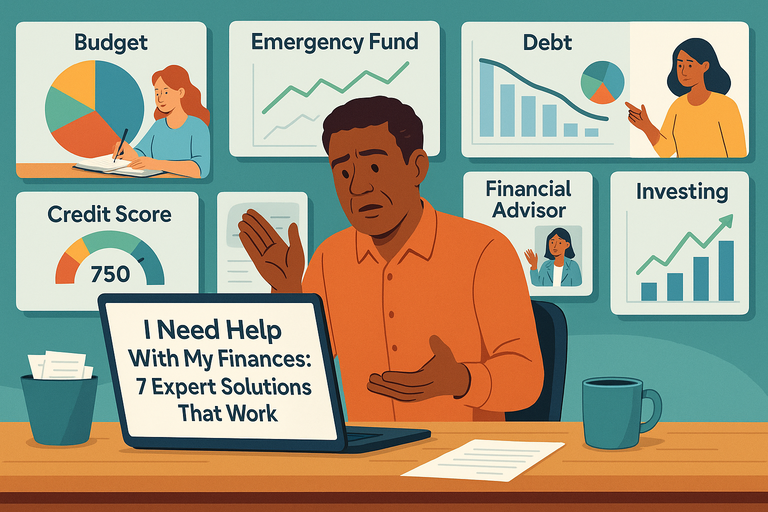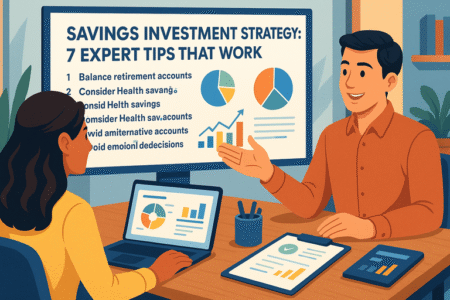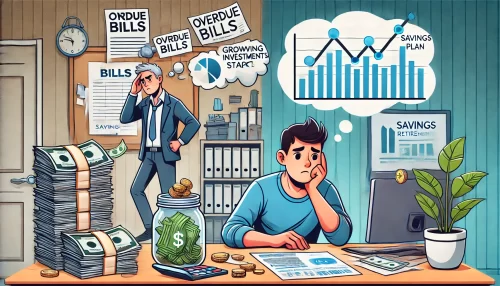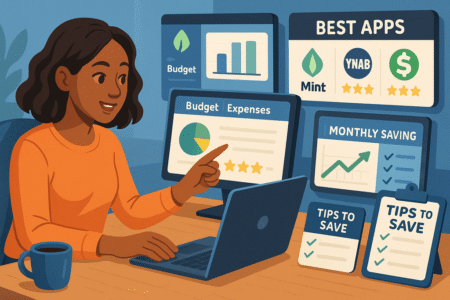Table of Contents
When I first whispered to myself, “I need help with my finances,” it wasn’t just about money—it was about peace of mind. Bills, savings, and debt can feel like a maze with no clear exit. Where do you even start when every dollar seems to already have a job?
In this guide, I’ll share 7 expert solutions that actually work and show you step-by-step how to move from financial stress to financial control. Which of these strategies could make the biggest difference for you?
1. Create a Clear and Actionable Monthly Budget
Getting a grip on your money always starts with a budget. A monthly budget is not a punishment — it’s a map.
When you can see exactly where your money flows, you stop guessing and start making decisions with confidence.
Track Spending To See Where Money Really Goes
The first step in any budget isn’t cutting, it’s noticing. Most of us underestimate how much we spend on things like food, subscriptions, or rideshares.
I suggest tracking your expenses for at least one full month. You can use your bank app, a spreadsheet, or a free tool like Mint.
When you categorize every transaction — groceries, dining out, entertainment, transportation — you start spotting patterns. Maybe your $4 coffee habit is closer to $100 a month, or delivery fees are quietly eating up $60.
These realizations give you leverage. You can’t fix what you can’t see, and a budget begins with honesty.
Use Simple Budgeting Tools To Stay Consistent
Writing numbers down in a notebook works for some, but I believe digital tools save time and keep you more accountable. Apps like YNAB (You Need A Budget) or EveryDollar help you assign every dollar a “job.”
From the dashboard, you’ll see categories like Rent, Utilities, Debt Payments, and Fun Money. You can drag and adjust as life changes. The benefit is automation: Once you link your bank account, the app pulls in your transactions. No more guessing or manually updating every little purchase.
Consistency is the real power of these tools. Instead of budgeting once and forgetting, you’re nudged to check in daily or weekly. Think of it like a money fitness tracker.
Identify Non-Essential Expenses You Can Cut Back
When people hear “cut back,” they imagine giving up everything they love. That’s not what budgeting is about. It’s about trade-offs. If you want to travel more, maybe you cook at home four nights a week instead of ordering out.
One method I suggest is the “keep, cut, adjust” list. Write down your monthly spending categories and mark each:
- Keep: essential or brings you joy (rent, gym membership you actually use).
- Cut: unused subscriptions, impulse shopping, apps you forgot you had.
- Adjust: dining, entertainment, clothing — where you can spend less without losing quality of life.
This exercise doesn’t just save money. It makes you intentional. Suddenly, you’re choosing your priorities instead of letting your spending choose them for you.
Adjust Budget Monthly To Reflect Real Life Changes
Budgets fail when they’re treated like stone tablets. Life changes every month — birthdays, car repairs, seasonal bills. That’s why I advise treating your budget like a living document.
At the end of each month, sit down for 15 minutes and ask: What worked? Where did I overspend? What’s coming up next month?
For example, in December you might allocate more to gifts, while in January you might plan for higher utility bills.
I recommend scheduling a recurring “money date” with yourself on the same day each month. It doesn’t have to be boring. Brew a coffee, play your favorite playlist, and review your numbers.
With this habit, your budget becomes less about restriction and more about control and freedom.
2. Build an Emergency Fund for Peace of Mind
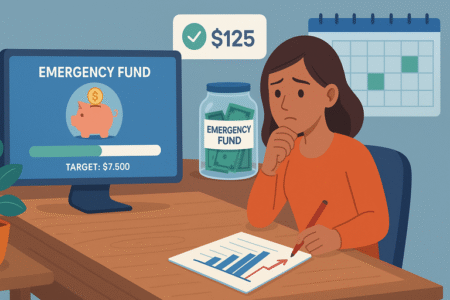
Once your budget is set, the next move is building a safety net. An emergency fund isn’t glamorous, but it’s one of the smartest shields you can give yourself.
It protects you from surprise expenses so you don’t spiral into debt.
Start Small and Automate Savings Every Month
Many people get stuck because they think they need thousands right away. I suggest flipping that mindset. Start with a goal of just $500. That’s enough to cover a car repair, a broken phone, or a surprise medical bill.
Automation makes it easier. Set up an automatic transfer from your checking account into a savings account right after payday. Even $25 a week adds up to $1,300 in a year.
The trick is consistency, not size. You want your emergency fund to grow in the background without you having to think about it.
Separate Emergency Savings From Everyday Accounts
One common mistake is keeping your emergency money in the same account you use daily. It’s too easy to dip into it for non-emergencies.
I recommend opening a separate savings account at your current bank or even at a different bank entirely.
When the money is out of sight, it’s out of mind. You’ll only touch it for genuine emergencies, like job loss, medical bills, or urgent home repairs. This separation creates a mental barrier that protects your future self from your present impulses.
Decide On the Right Target Amount for Your Situation
How much should you save? The common advice is 3–6 months of living expenses. But here’s the truth: that can feel overwhelming when you’re just starting out.
I suggest breaking it into milestones:
- Milestone 1: $500 for basic emergencies.
- Milestone 2: One month of essential expenses.
- Milestone 3: Three months of essential expenses.
If you have kids, own a home, or freelance, aim for closer to six months. If you’re single and renting, three months might be enough. Your lifestyle and risk factors determine the right target — not a cookie-cutter number.
Use High-Yield Savings Accounts for Better Growth
Your emergency fund isn’t meant to make you rich, but it shouldn’t sit idle either. Traditional savings accounts pay almost nothing in interest. That’s why I suggest using a high-yield savings account (HYSA).
Many online banks offer 3–4% annual percentage yield (APY), which means your money grows a bit while staying safe and accessible. For example, $5,000 in an HYSA at 4% earns around $200 a year — without you lifting a finger.
The key here is accessibility. Don’t invest your emergency fund in stocks or long-term CDs where the money is locked up. You want peace of mind knowing you can get to it instantly, without penalties.
Pro tip: Pair your budget with your emergency fund by labeling the fund as its own “category” in your budget app. Watching it grow month after month gives you a powerful sense of progress and safety.
3. Develop a Smart Plan To Pay Off Debt Faster
Debt can feel like carrying a backpack filled with bricks — every payment lightens the load a little, but it can take years if you don’t have a strategy.
The good news is there are proven ways to pay it off faster without draining every ounce of joy from your life.
Prioritize High-Interest Debt To Save Money
Credit card balances with 20%+ interest are like quicksand. If you only make minimum payments, most of your money goes to interest instead of the principal.
I advise listing all your debts on a single page — include balance, interest rate, and minimum payment. Then rank them by interest rate, highest to lowest.
Every extra dollar should go toward that top debt while you keep making minimum payments on the rest. This method saves you the most money in the long run.
I once had a $1,800 balance at 24% APR, and knocking that out first saved me hundreds in wasted interest. It’s math, plain and simple.
Explore Debt Snowball and Avalanche Methods
There are two main repayment methods people talk about:
- Avalanche: Pay off the highest interest rate first (fastest, mathematically smartest).
- Snowball: Pay off the smallest balance first (psychologically motivating).
Both work, but I believe your personality decides which one is best. If you’re motivated by quick wins, the snowball builds momentum and confidence. If you’re numbers-driven, avalanche saves you the most money.
For example, say you have:
- $300 at 15% APR
- $1,200 at 22% APR
- $5,000 at 6% APR
With avalanche, you’d attack the $1,200 first. With snowball, you’d wipe out the $300 quickly to get a win. I recommend running both scenarios in a debt calculator — it’s eye-opening.
Negotiate Lower Interest Rates With Lenders
Here’s a trick most people skip: call your credit card company and ask for a lower interest rate. It sounds intimidating, but it can cut months off repayment.
Script it simply: “I’ve been a customer for X years. I want to keep my account, but I’m struggling with the interest rate. Can you lower it?”
I’ve seen rates drop by 3–6% with one phone call. Even if they only say yes temporarily, it buys you time to pay down faster. You can also ask about hardship programs — some lenders freeze interest for a few months if you show good faith effort.
Consolidate Debt When It Makes Financial Sense
Consolidation isn’t a magic wand, but it can simplify things. If you have multiple high-interest cards, rolling them into a single personal loan with a lower rate can save money and reduce stress.
Here’s when I suggest it makes sense:
- Your credit score qualifies you for a significantly lower rate.
- You can commit to not racking up new card debt while paying off the loan.
- The loan term doesn’t stretch so long that you end up paying more in total interest.
Balance transfer cards are another option if you qualify. Some offer 0% APR for 12–18 months. Imagine transferring a $5,000 balance and paying it off with no interest — that’s hundreds saved.
Just make sure to calculate transfer fees and pay it off before the promo ends.
4. Boost Income With Practical Side Hustles
Sometimes cutting expenses isn’t enough. To really move the needle, boosting your income adds fuel to your financial plan.
The trick is picking side hustles that work for your lifestyle, not ones that burn you out.
Choose Flexible Gigs That Fit Your Lifestyle
Flexibility is key — especially if you already work full-time or have family responsibilities. Driving for Uber or Lyft works if you want to set your own hours. Delivery apps like DoorDash or Instacart can bring in an extra $100–$300 per week with just a few evening shifts.
If you’re more introverted, remote gigs like transcription, freelance writing, or virtual assistance might suit you better. The goal is finding something sustainable so you don’t quit after a month.
I advise starting small: Try one shift a week and see how it feels. You can always scale up later.
Leverage Online Platforms To Find Reliable Work
The gig economy has exploded, which means finding side hustles is easier than ever. Platforms like Upwork, Fiverr, and Freelancer let you market skills ranging from graphic design to voiceover work.
Here’s a practical example: On Fiverr, you can create a profile, upload a sample (say, a 200-word blog post if you’re a writer), and set a starting rate. From the dashboard, click “Gigs > Create a New Gig” to launch your first listing. Clients search, find your profile, and hire you.
I suggest browsing the top sellers in your category to see how they structure their services. It’s like peeking behind the curtain.
Turn Skills or Hobbies Into Extra Income
Not every side hustle has to come from apps. Think about what you already enjoy. Are you great with pets? Dog walking or pet sitting through Rover or even just in your neighborhood can bring in steady income. Love photography? Offer mini photo sessions on weekends.
I once had a friend who made $400 a month teaching guitar lessons out of his living room. Another started selling homemade candles on Etsy and turned it into a full-time business. You don’t need to reinvent yourself, just monetize what you already know.
Set Clear Goals for How Side Income Will Be Used
The fastest way to lose motivation with a side hustle is to let the money blend into your checking account. Instead, I recommend assigning every dollar a purpose.
- Paying off debt faster.
- Building your emergency fund.
- Saving for a vacation or down payment.
Let’s say you bring in $300 extra per month. If you direct all of it toward debt, that’s $3,600 a year shaved off your balance. Seeing the progress fuels motivation. Without clear goals, the money disappears into impulse spending.
Pro tip: Pair a side hustle with a debt payoff strategy. Imagine working two DoorDash shifts a week and putting that extra $200 straight toward your highest-interest credit card. That’s like accelerating time on your financial journey.
5. Improve Credit Score With Consistent Habits
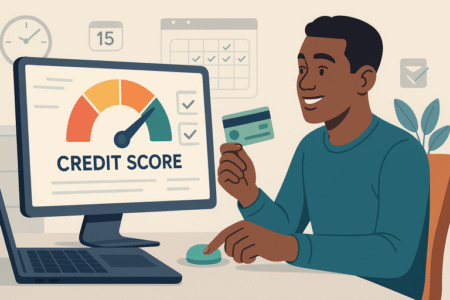
A strong credit score is like a financial passport — it unlocks better interest rates, cheaper insurance premiums, and even more job opportunities.
The best part? You don’t need tricks or gimmicks, just consistent habits that build over time.
Pay Bills on Time To Build Positive Credit History
Your payment history makes up the largest slice of your credit score. Even one late payment can ding your score for years. That’s why I always suggest setting up automatic payments.
From your bank app or credit card portal, go to “Payments > Autopay” and select at least the minimum due. This way, you’ll never miss a deadline. If you’re worried about overdrafting, set reminders on your phone a few days before each due date.
Think of it like planting seeds: every on-time payment is a seed that grows into a stronger credit history. Missed payments, on the other hand, are weeds that take ages to pull out.
Keep Credit Utilization Below Recommended Levels
Credit utilization is the ratio of how much credit you’re using compared to your total limit. Experts say keeping it under 30% is good, but under 10% is even better.
Let’s say you have a $5,000 limit. If you keep your balance under $500, you’re sending a powerful signal to lenders that you manage credit responsibly.
One tip I use is paying down balances multiple times a month. Instead of waiting for the due date, I make small payments throughout the billing cycle. This keeps reported balances low and helps scores climb steadily.
Monitor Reports for Errors That Lower Scores
Errors on credit reports are more common than people think. A wrong balance, a closed account listed as open, or even someone else’s debt showing up can drag your score down unfairly.
I recommend pulling your free credit reports from all three bureaus once a year at AnnualCreditReport.com. Review each section carefully. If you spot something wrong, file a dispute directly through the bureau’s website.
I once caught a $600 medical bill that wasn’t even mine — disputing it bumped my score by 40 points.
Use Credit-Building Tools Like Secured Cards
If you’re just starting or rebuilding credit, secured credit cards are a great tool. You put down a cash deposit (say $300), and that becomes your limit. Use it for small purchases like gas or groceries, then pay it off in full each month.
The key is patience. After 6–12 months of responsible use, many banks will upgrade you to an unsecured card and refund your deposit. It’s like training wheels for your credit score — not glamorous, but incredibly effective.
6. Work With a Financial Advisor for Expert Guidance
Sometimes managing money alone feels overwhelming, and that’s where a financial advisor can step in.
The right advisor doesn’t just crunch numbers; they help you build a strategy that fits your actual life.
Understand When Professional Help Is Worth It
If you’re juggling multiple goals — like saving for retirement, paying off debt, and planning for a home — a financial advisor can help you balance it all. I usually recommend seeking one when your financial situation feels too complex for DIY.
For example, if you just inherited money, started a business, or want tax strategies beyond the basics, professional help is worth every penny.
Find Fee-Only Advisors To Avoid Hidden Conflicts
Not all advisors are created equal. Some earn commissions by selling you products, which can cloud their advice. I strongly suggest looking for “fee-only” advisors — they’re paid a flat fee or hourly rate, not commissions.
From your first meeting, ask directly: “How are you compensated?” A trustworthy advisor will answer clearly. Fee-only means their advice aligns with your goals, not their paycheck.
Prepare Questions To Maximize Each Appointment
Walking into a meeting with an advisor unprepared is like going to the doctor and forgetting your symptoms. Make a list of questions ahead of time:
- Am I saving enough for retirement?
- How should I balance investing vs. debt payoff?
- Are my insurance policies protecting me properly?
- How can I reduce my taxes legally?
The more specific your questions, the more value you’ll get from that hour. I once brought in a question about optimizing my 401(k) contributions, and the answer saved me hundreds in taxes the following year.
Combine Professional Advice With Your Own Goals
Here’s the trap to avoid: Blindly following every word an advisor says. Their advice should be a tool, not a command. Always check if recommendations match your actual goals.
If an advisor tells you to max out retirement savings but you’re still drowning in credit card debt, pause and discuss priorities.
It’s your life, your money — you get the final say. The best advisors know this and respect it.
7. Invest in Long-Term Financial Growth
Budgeting and debt payoff give you stability, but investing is what builds wealth. Think of it as planting trees: the earlier you plant, the sooner you’ll enjoy the shade.
Learn the Basics of Stocks, Bonds, and ETFs
Investing doesn’t have to be complicated. Stocks are pieces of companies. Bonds are loans you give to governments or corporations. ETFs (Exchange Traded Funds) are baskets of stocks or bonds you can buy with one click.
Here’s how I explain it: stocks are like rollercoasters (high risk, high reward), bonds are like buses (slower, steadier), and ETFs are like tour packages (a little bit of everything). Once you know the basics, the fear around investing starts to fade.
Start With Small, Automated Investments
The biggest mistake is waiting until you “have enough” to start investing. Even $50 a month matters because of compound growth. I suggest using apps like Acorns or Betterment, which round up your purchases and invest the spare change.
From the app dashboard, you can literally set “Round-Ups > Auto-Invest” and watch pennies grow into dollars. Automation removes the friction and keeps you consistent, even when life gets busy.
Take Advantage of Employer-Sponsored Retirement Plans
If your employer offers a 401(k) with a match, grab it. That match is free money — a guaranteed 100% return on your contributions up to the match amount.
Let’s say you earn $50,000 and contribute 5% ($2,500). If your employer matches 5%, you instantly double it to $5,000. It’s like your boss is paying part of your future salary in advance. Skipping this is leaving money on the table.
Diversify Investments To Reduce Risk Over Time
Diversification means not putting all your eggs in one basket. Instead of buying just tech stocks or just real estate, spread across different sectors and asset types.
I use a simple rule: 80% in broad market ETFs (like S&P 500 index funds), 20% in bonds for stability. Over time, you can tweak the mix based on age and risk tolerance.
Diversification doesn’t eliminate risk, but it cushions the blows. When one sector dips, another usually holds steady or climbs. It’s about steady growth, not gambling.
Pro tip: Treat investing like watering plants — a little, consistently, over time. You don’t need to check the stock market daily. Focus on adding to your investments regularly and let compounding do the heavy lifting.


